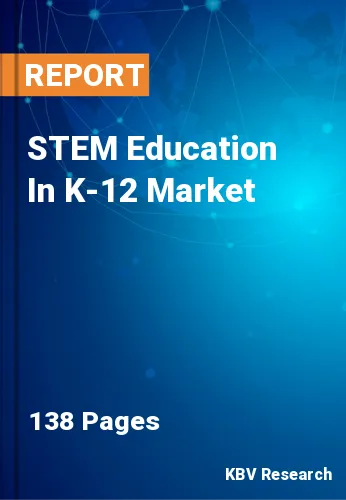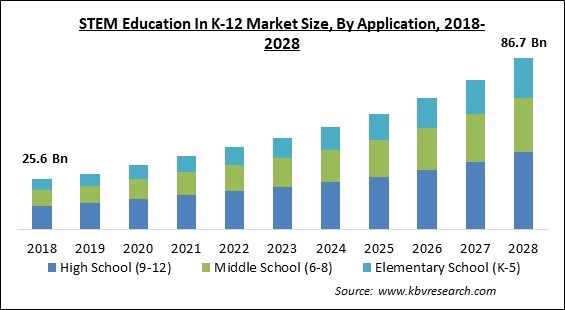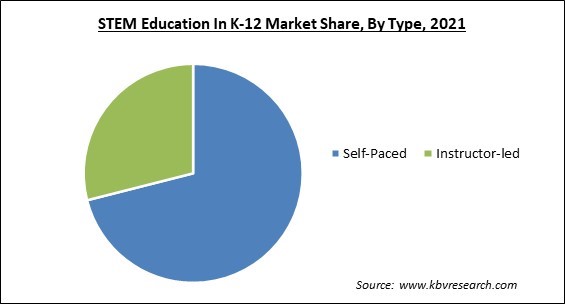
The Global STEM Education In K-12 Market size is expected to reach $86.7 billion by 2028, rising at a market growth of 13.0% CAGR during the forecast period.
STEM education refers to the concept of education specific to four disciplines which includes science, technology, engineering, and mathematics. These four disciplines are considered as four pillars of the economy as they play an important role in preventing any possible future crisis. Through STEM education, the students at primary & secondary levels learn about facts & methods of thinking to solve problems that may occur in the real world.

STEM education may accelerate entrepreneurship as well as the start-up culture, as the learners would be educated about the real world. Furthermore, the emergence of smart gadgets has resulted in the presence of a large number of apps. Every such app is a solution and could be a separate organization.
This offers more employment opportunities worldwide, many of which are from successful ventures. Thus, STEM education may be a solution to tackle possible future unemployment issues. Nowadays, it is crucial to introduce children to STEM education at the primary level and to familiarize them with terms such as websites and coding.
Children are now more exposed to smart gadgets such as mobile phones, voice assistance, etc., and because of this, it is natural that they have many unsolved queries regarding the technology. The subjects such as coding, AI, and robotics are being introduced to children at an early age by various ed-tech providers.
The outbreak of COVID-19 has negatively affected the world’s economy. The pandemic has resulted in lockdowns across the globe, along with mass quarantines and the need for social distancing to prevent the spread of the virus. In addition, the pandemic period has caused significant disruption to the education system in K-12. The worldwide lockdowns and shutdown of various sectors also included the closure of educational programs & academic institutions, which has also negatively impacted STEM education. Due to imposed restrictions, various schools had to stop in-person learning and shift to computer-based education systems.
The emergence of software solutions would serve institutes with enhanced resource planning systems which help faculty members to design more advanced courses along with making them capable of managing classrooms & schools efficiently. Various online learning platforms allow teachers to address a large number of students in a group by creating virtual classrooms. These platforms provide students with a direct connection to their teacher.
The application and adoption of artificial intelligence in various sectors are continuously rising, and the education sector is no exception. Artificial intelligence is increasingly being used at schools and educational institutes to improve teacher and student engagement by making learning more practical and exciting. The growing adoption of AI in classrooms would support the acceptance of STEM education. Artificial intelligence for K-12 is becoming common nowadays.
In order to have successful STEM integration, the need for adequate resources & infrastructure, such as time, space, and cutting-edge technologies, arises. In addition, educators are required to work collaboratively with colleagues of other disciplines while addressing STEM lessons. This further raises the need for more efficient infrastructure. The requirement for advanced infrastructure raises a need for a large number of funds to be invested initially and, in some cases, repetitively as new technologies are continuously being introduced in the market.
On the basis of type, the STEM education in K-12 market is segmented into self-paced and instructor-led. In 2021, the self-paced segment dominated the STEM education in K-12 market with maximum revenue share. This is because of the growing popularity of individualized learning, which enables students to learn at their own pace. Various self-learning platforms, such as FutureLearn, and Pearson, are emerging across the globe. Self-paced learning is gaining traction in primary & elementary grades.

Based on application, the STEM education in K-12 market is fragmented into elementary school (K-5), middle school (6-8), and high school (9-12). The elementary school segment covered a substantial revenue share in STEM education in K-12 market in 2021. The concept of STEM education has gained massive attention among the elementary education systems. It is expected that the elementary school segment would widely adopt the concept of STEM education in their curricula to enable the student to enhance their science & technology skills.
| Report Attribute | Details |
|---|---|
| Market size value in 2021 | USD 37.1 Billion |
| Market size forecast in 2028 | USD 86.7 Billion |
| Base Year | 2021 |
| Historical Period | 2018 to 2020 |
| Forecast Period | 2022 to 2028 |
| Revenue Growth Rate | CAGR of 13% from 2022 to 2028 |
| Number of Pages | 138 |
| Number of Tables | 250 |
| Report coverage | Market Trends, Revenue Estimation and Forecast, Segmentation Analysis, Regional and Country Breakdown, Companies Strategic Developments, Company Profiling |
| Segments covered | Type, Application, Region |
| Country scope | US, Canada, Mexico, Germany, UK, France, Russia, Spain, Italy, China, Japan, India, South Korea, Singapore, Malaysia, Brazil, Argentina, UAE, Saudi Arabia, South Africa, Nigeria |
| Growth Drivers |
|
| Restraints |
|
Region wise, the STEM education in K-12 market is analyzed across North America, Europe, Asia Pacific and LAMEA. In 2021, the North America region led STEM education in K-12 market by generating the highest revenue share. The United States would widely incorporate STEM education in its education system due to the favorable policies offered by the government. Not only the schools & private organizations but the policymakers are also promoting STEM education in K-12.
Free Valuable Insights: Global STEM Education In K-12 Market size to reach USD 86.7 Billion by 2028
The market research report covers the analysis of key stake holders of the market. Key companies profiled in the report include Stride, Inc., edX, Inc. (2U, Inc.), BYJU'S, Hurix Systems Pvt. Ltd., STEM Learning Ltd., MEL Science, STEMI d.o.o., STEMROBOTM Technologies Pvt Ltd., Edutech, and StemLabs Education.
By Type
By Application
By Geography
The STEM Education In K-12 Market size is projected to reach USD 86.7 billionby 2028.
Emergence of Online Learning Platforms are driving the market in coming years, however, Need of Adequate Infrastructure Rises Overall Cost restraints the growth of the market.
Stride, Inc., edX, Inc. (2U, Inc.), BYJU'S, Hurix Systems Pvt. Ltd., STEM Learning Ltd., MEL Science, STEMI d.o.o., STEMROBOTM Technologies Pvt Ltd., Edutech, and StemLabs Education.
The High School (9-12) segment acquired maximum revenue share in the Global STEM Education In K-12 Market by Application in 2021 thereby, achieving a market value of $39.2 billion by 2028.
The North America market dominated the Global STEM Education In K-12 Market by Region in 2021, and would continue to be a dominant market till 2028; thereby, achieving a market value of $38.4 billion by 2028.
Our team of dedicated experts can provide you with attractive expansion opportunities for your business.
